Discussion on the Appraisal of Ancient Chinese Calligraphies and Paintings
Li Lin*
Abstract: Throughout Chinese history there have been many outstanding calligraphers and painters who have left behind numerous masterpieces. There have also been endless copycats, forgeries and ghost-creations bringing much trouble and chaos to the appreciation and study of ancient Chinese calligraphies and paintings. Based on certain theories and practices of calligraphy and painting appraisals, this paper summarizes eight basic approaches to the appraisal of ancient Chinese calligraphies and paintings used to separate the true from the false.
Keywords: ancient Chinese calligraphies and paintings, forgery, appraisal approaches
Throughout Chinese history, however, there have also been endless copycats, forgeries and ghost-creations which have created much trouble and chaos in the appreciation and study of ancient Chinese calligraphies and paintings. Thus, it is of great necessity to accurately appraise ancient calligraphies and paintings to sift the true from the false. Ancient calligraphy and painting appraisal mainly concerns evaluating the artistic value of artistic pieces and, above all, identifying their authenticity. This paper, based on years of theoretical cultivation and frontline practice, showcases how to analyze and identify the authenticity of ancient Chinese calligraphies and paintings through scientific approaches.
1. Forging calligraphies and paintings: A historical review
It has been an enduring practice since ancient times to produce copies and forgeries of original calligraphies and paintings, particularly those of renowned artists. It is not rare to see forgeries handed down from ancient times. Some of these ancient forgeries were not intentionally made. Instead, they were originally imitations for practice purposes and were mistaken for authentic copies by later generations. Some were created by little known or anonymous artists and were falsified as masterpieces for higher prices. Others were ghost-created by artists’ relatives, friends or pupils. For example, Guan Zhongji’s Zhi San Zongguan Zha (A Letter to Three Governors), a collection held by the Palace Museum was in fact ghost-created by her husband Zhao Mengfu. In the Yuan Dynasty (1271-1368), forged calligraphies and paintings were on the rise. Nevertheless, no industry specializing in art forgery yet formed because such forgeries were not large in scale. Below are the universally-accepted forged pieces by artists in the Yuan Dynasty pretending to be the works of other artists of the Yuan Dynasty and earlier: Lin Han Gan’s Shizicong Tu (A Copy of Han Gan’s Fiery Steed), which was credited to Li Gonglin and is currently held by the Liaoning Provincial Museum; Gu Shan Tu (Lonely Mountain Painting), which was credited to Qian Xuan and is currently held by the Palace Museum, and Siji Taohua Yuan Tu (The Peach Garden in Four Seasons), which was credited to Qian Xuan and is currently held by the Shanghai Museum. Given that Qian Xuan’s paintings were popular targets for forgers in the Yuan Dynasty, Qian could do nothing but leave the inscription “Zhaxi Weng” (meaning an old man by the Zhaxi river) on his works in his later years to indicate authenticity.
In the Ming Dynasty (1368-1644), the booming economy facilitated active commercial exchanges of calligraphies and paintings. Accordingly, there was a significant increase in forgeries of original calligraphies and paintings by well-known artists during and prior to that period. Their approaches to forgery were diverse, including modification of and additions to original copies. Sometimes, the original painter’s inscription on a painting was erased and was replaced with the inscription of a renowned painter in the Song Dynasty (960-1279) to make a forgery. Also, an anonymous piece might be added with the inscription of a wellknown painter. Another approach to forgery was particularly imitating paintings by famous painters to forge pieces good enough to be passed as genuine. Painters most frequently targeted by this type of forgery were Shen Zhou, Zhu Yunming, Wen Zhengming, Tang Yin, Qiu Ying and Dong Qichang. There were also pieces created out of thin air by skilled forgers in well-known painters’ styles. Also, some forgeries were made by piecing together an artist’s handwritings.
In the Ming Dynasty, art forgery was highlighted by a regional feature. The most widely known, and also the largest center for art forgery, was arguably Suzhou with its forgery boom lasting from the Wanli era (1572-1620) of the Ming Dynasty to the mid Qing Dynasty (1736-1850). During that period, a group of skilled artists gathered in Suzhou, where they made a living by forging calligraphies and paintings. Their “works,” which were collectively known as “Suzhou copy,” were all forgeries of masterpieces by renowned artists. Some of those forgeries included prefaces and postscripts by big names such as Su Shi, Huang Tingjian, Zhao Mengfu and Wen Zhengming to indicate “authenticity.” There were forgers specializing in imitating and copying Along the River During the Qingming Festival by Zhang Zeduan. Among the numerous forged versions they produced, over twenty have come down through the ages and remained today. Some pieces were made by forgers at the will of famous calligraphers and painters to whom the pieces were credited. That was because these famous calligraphers and painters had too many clients to satisfy. To solve the short supply they hired other artists to create on their behalf and left their own inscriptions and seals on those pieces, which are known as “ghost-creation.” Among those who hired ghost-artists were Wen Zhengming and Dong Qichang, whose “ghost-created pieces” are still held by many museums.
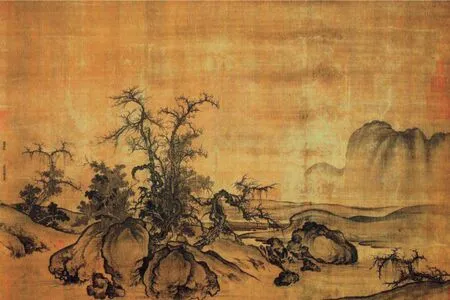
Rocks and Hills against Remote Mountains (Guo Xi, the Northern Song Dynasty)
In the Qing Dynasty, there were even more forgeries of ancient calligraphies and paintings which fall into two basic categories. The first is “complete forgery,” which consists of Mo (tracing, i.e. completely following the drawing lines of the original), Lin (copying, i.e. replicating the original), Fang (imitation, i.e. imitating the style of a renowned artist instead of a particular piece), and Zao (creation, i.e. creating a piece out of thin air regardless of the original appearance).
The second category is “region-specific forgery,” such as the aforementioned “Suzhou copy,” “Yangzhou copy,” “Henan forgery,” “Hunan forgery,” “Guangdong forgery” and “Houmen (Beijing) forgery,” all of which continued until modern times.
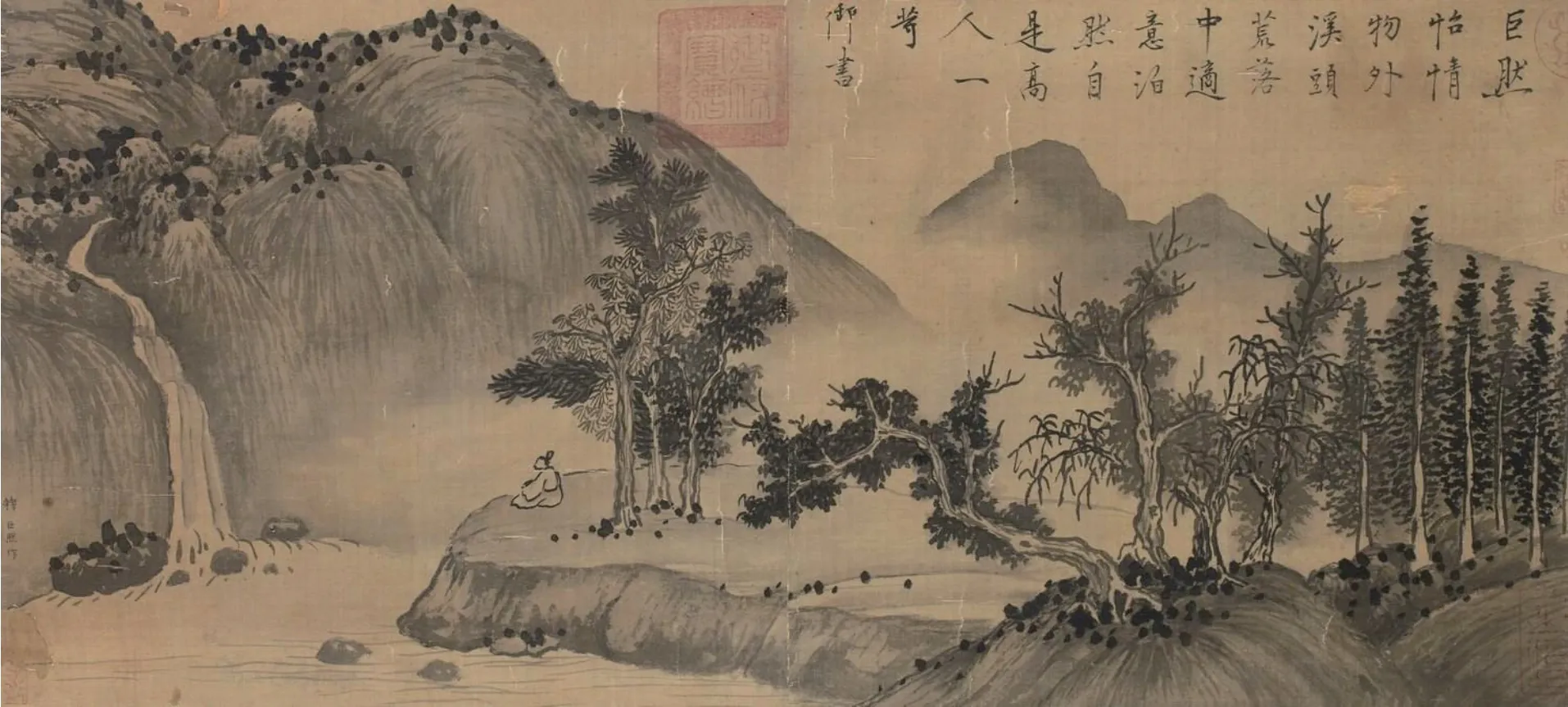
Appreciating the Waterfall from the Other Shore (Ju Ran, the Song Dynasty)
There was also falsification of authentic ancient calligraphies and paintings. Authentic pieces were forged through falsifications, additions, deletions, recombinations, as well as separations. Specifically, falsification, the most common means of forgery, refers to erasing the true and authentic inscription and seal on a piece and replacing them with the inscription and seal of some renowned ancient artist; addition refers to adding the inscription and seal of a renowned artist to an anonymous piece; adding a renowned artist’s preface and postscript, along with corresponding time to a piece created in the Qing Dynasty; or adding some content and a forged seal to increase its market value. Deletion refers to deleting the original inscription of a less known artist and adding a big name’s inscription, preface and postscript. Regarding recombination and splitting, there were many more methods, such as matching an authentic preface and postscript with a forged calligraphy or painting, or vice versa, piecing together the authentic work of a lesser known artist and the forged work of a renowned artist, splitting an album of paintings or Tiaoping (stripped painting) into several pieces, or separating a sound and complete piece into several parts.
Ghost-created pieces, unlike other forged calligraphies and paintings, were completed under an agreement or authorization of a patron (to whom the piece is credited). The practice of ghost-creation makes it difficult to differentiate a true and authentic piece from a ghost-created one but is nevertheless a type of forgery. Patrons of ghost-creation were commonly found in calligraphy, with Emperor Qianlong (1711-1799) being the most well known.
The fox climbed up stealthily and caught the little creatures with his paws one after the other; and when he had killed them all he put their blood into a little bottle which he wore at his side and returned with it to Grannonia, who was beside herself with joy at the result of the fox s raid
2. Eight basic approaches to the appraisal of ancient Chinese calligraphies and paintings
The seemingly enigmatic and profound appraisal of ancient Chinese calligraphies and paintings, through long-term learning, observation, comparison and study, can be thoroughly grasped and acquired. Correct judgments can be made based on a good command of knowledge concerning relevant history, aesthetics and literature, a basic understanding of primary approaches to the creation and mounting of calligraphies and paintings, and continuous practice of comparison and analysis between an authentic piece and its forgeries. Based on certain theories and appraisal practices used by myself and others, this paper summarizes eight basic approaches to the appraisal of ancient Chinese calligraphies and paintings.
2.1 Approaching the appraisal from a historical background
The formation of a calligraphy or painting style is closely related to the social background and customs in which it is set. Accordingly, calligraphies and paintings of a particular period feature a defining period style, which is an essential point not to be overlooked in the appraisal of ancient Chinese calligraphies and paintings. Take ancient Chinese painting as an example. The painting techniques prior to the Yuan Dynasty were different from those in and after the Yuan Dynasty. Prior to the Tang Dynasty (618-907) and the Song Dynasty (960-1279), murals (wall paintings) were the dominant form of painting. Painters during that period were all standing in front of a wall while painting. Even when they painted on a silk piece, they would stretch the piece over a picture frame so that they could stand in front of the frame when painting. Their approach is similar to those of western oil painters and modern Thang-ga painters. In the Song Dynasty, people began to paint on a piece of paper or silk spread on a desk. Standing up while painting is quite different from painting on a flat face in terms of brush-handling and stroke strength. Given that, works created in the two approaches delivered distinct effects.
As for Chinese calligraphy, its writing instruments and styles have continuously evolved from ancient times. For example, prior to the Song Dynasty, people sat on the ground to write, with one hand holding bamboo slips and the other holding the Chinese brush. While writing, they had their elbow hanging in the air. Later, with the introduction of the writing desk, they no longer needed to keep that laborious gesture and accordingly re-adjusted the way they held the Chinese brush. Originally, the requirements of script styles and writing forms for the Imperial Examination varied from dynasty to dynasty. Later, the requirements were gradually standardized and Xiao Kai Shu (small regular script) became the designated style for the answer sheet in the Imperial Examination. With writers’ elbows and even wrists getting closer to the desk, a new calligraphy style, i.e. the so-called Guan Ge Ti (a “monotonous” court style of calligraphy) was derived.

Wild Herbs Picking (Cai Wei Tu) (Li Tang, the Southern Song Dynasty)
Also, period style is reflected in the diction, sentence structure, tone of voice, formatting style, as well as appellation. For example, the word “qiangu” (meaning the eternal) was an honorific for the living in the Ming Dynasty, but now only for the deceased. The inscription “Proudly entrusted by Mr. XXX” was commonly found in the calligraphies and paintings of the Qing Dynasty but not in the pieces of the Ming Dynasty or earlier. There are other details like the artist’s dates of birth and death, the life system reflected and the taboo words can also directly or indirectly help identify a work’s age of creation and its authenticity.
The characters’ costumes, the architecture, the vessels and vehicles, as well as the daily utensils depicted in an ancient painting are closely related to the then social customs and systems for which they were the defining features of the times. Whether the objects in a painting correspond to the style of the period it is supposed to belong to is also an important basis for appraisal. After all, a man in a Chinese tunic suit is not supposed to appear in a painting of the Qing Dynasty.
The presenting formats of ancient Chinese calligraphies and paintings also varied from dynasty to dynasty. For example, circular fans were popular in both the Song and Yuan dynasties but were seldom seen in the Ming Dynasty; and the circular-fan fashion was not revived until the era under the reign of Emperor Daoguang of the Qing Dynasty. Given that, a circular-fan painting claimed to belong to the Ming Dynasty should be handled with particular caution. By contrast, the folding fan became popular in the early years of the Ming Dynasty. The initial fashion was to leave an inscription on the unfolded sheet of a fan. Later, painting on the unfolded sheet was accepted. Thus an inscribed or painted folding fan claimed to belong to an era prior to the Ming Dynasty is not likely to be authentic. Also, antithetical couplets came into being in the late Ming Dynasty and did not become popular until the reign of Emperor Qianlong of the Qing Dynasty. Therefore, antithetical couplets claimed to belong to the Song and Yuan dynasties are bound to be forgeries.
2.2 Approaching the appraisal from individual styles
Historical backgrounds are abstract, while individual styles are more specific. Calligraphers and painters have quite different artistic thoughts, aesthetic tastes, personalities, habits and even preferred tools. Their works inevitably demonstrate their unique styles and characteristics. This can be exemplified by well-known individualistic artists such as Liu Yong, a prime minister and painter known for his “strong and heavy strokes;” Wang Wenzhi, a third winner in the Imperial Examination and a calligrapher who excelled at “l(fā)ight and elegant strokes;” and Zheng Banqiao, a renowned painter and calligrapher known for his vivid ink painting of bamboos and “Banqiao calligraphy style.”
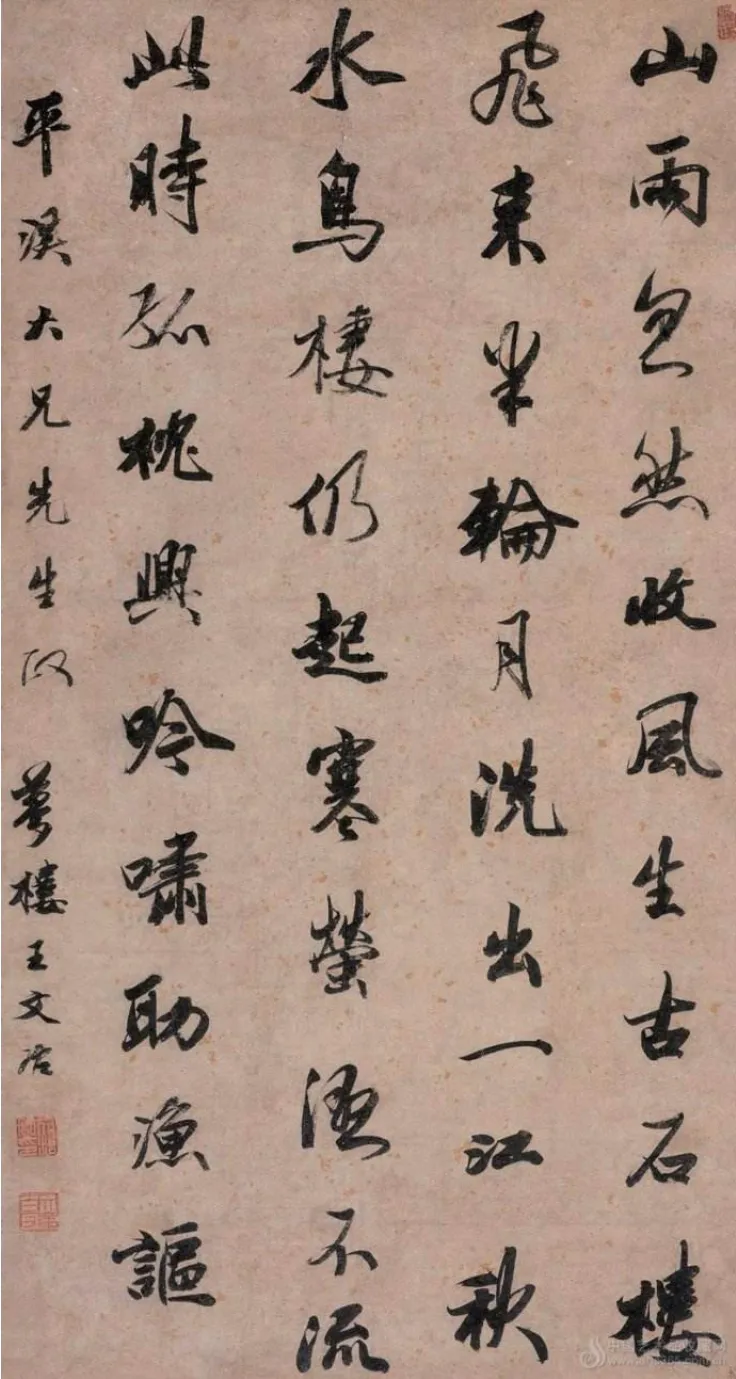
Calligraphy by Wang Wenzhi, the Qing Dynasty
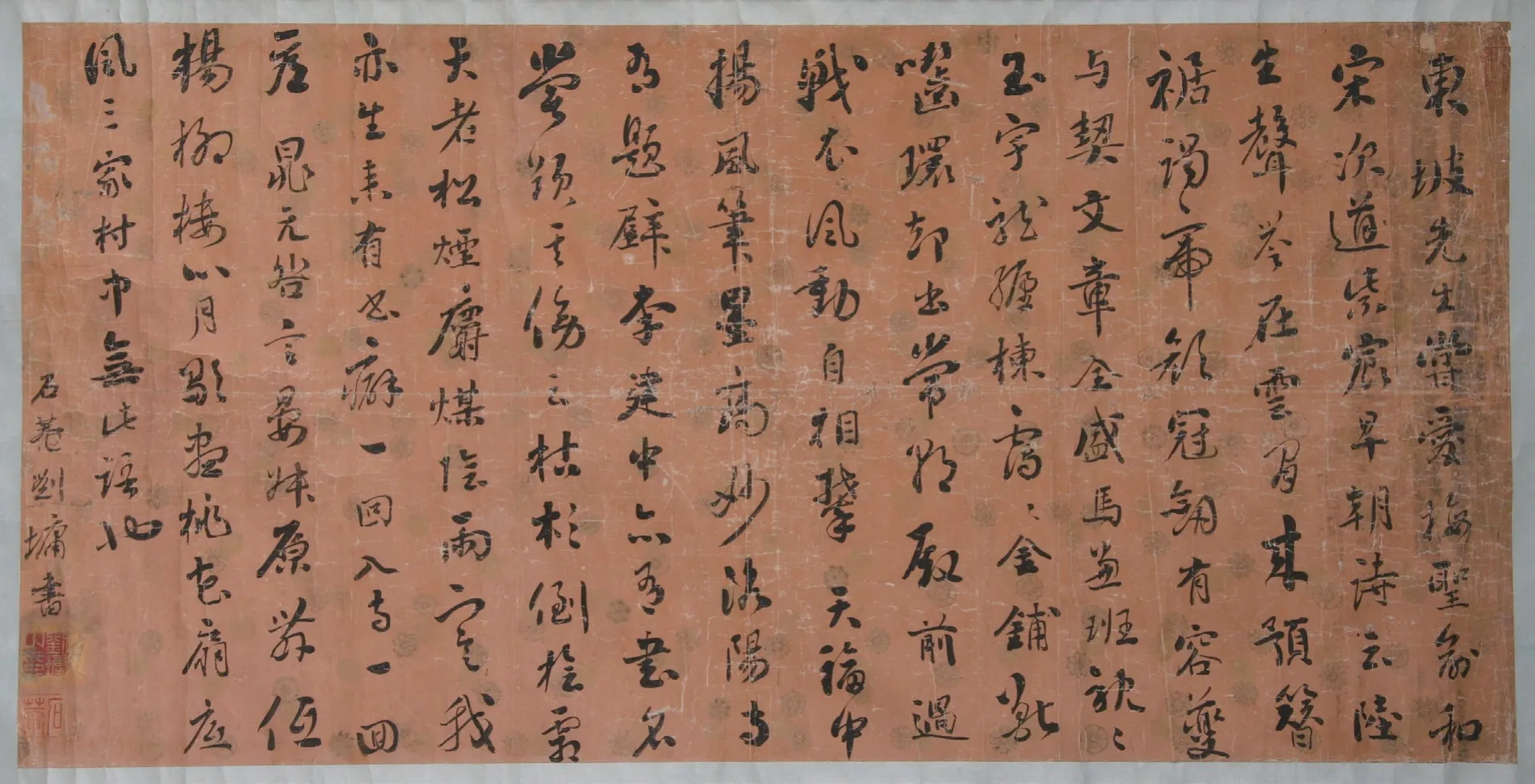
Calligraphy by Liu Yong, the Qing Dynasty
Take traditional Chinese landscape painting as another example. In the early days, landscape painting did not attach much importance to proportion but mainly captured the full view of a scene. The paintings of two painters, Li Cheng and Guo Xi in the Northern Song Dynasty (960—1127), were all the scenery of the Central Plain. By contrast, Li Tang, Ma Yuan and Xia Gui, three painters in the Southern Song Dynasty (1127—1279) focused on painting scenery on a mountainside or at the foot of a mountain. Ma Yuan developed a reputation for “Ma’s corner view,” while Xia Gui was famous for “Xia’s halffull view.” These are all presentations of the individual styles of painters and calligraphers and connoisseurs are supposed to know and understand them clearly.
2.3 Approaching the appraisal from the artist's seal
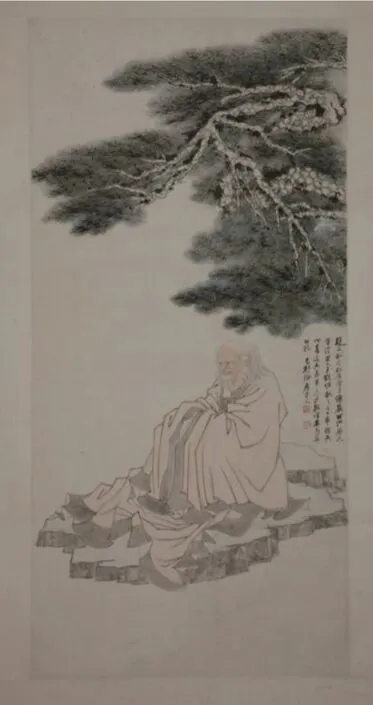
Philosopher Laozi Seated on a Rock under a Pine Tree (Zhang Daqian)
Affixing a seal on a piece of work is a universal practice by calligraphers and painters to acknowledge their works and by connoisseurs to confirm their appraisals. Seal-affixing is a serious and prudent matter for calligraphers, painters and connoisseurs. Therefore, seals serve as a crucial means of verifying the authenticity of a piece of work. Depending on the periods and owners, seals are different in style, shape, seal-writing, seal-cutting, material, ink-paste type and color, as well as the owner’s habit of sealing. Seals in the Song Dynasty feature a diversity of shapes, such as bell and tripod. That diversity, however, was on the wane during the Ming Dynasty. Song people had the habit of fabricating Chinese character styles and carving them onto seals, making it hard to recognize them. In the mid Qing Dynasty, the approaches to seal cutting became more rigorous and precise. In terms of Jin Shi cutting (copper and stone cutting), the Ming Dynasty witnessed the emergence of the Wen school, while the Qing Dynasty saw a contention between the Anhui school and the Zhejiang school, each of which had a seal layout and cutting approach of its own. So, if a painting with an inscription claimed to belong to the Yuan Dynasty is found bearing a seal in the Zhejiang school style, this piece can initially be identified as one whose seal was added by someone in a later generation and, worse still, whose painting and inscription may even be forged. In terms of ink paste, people in the Song Dynasty preferred beeswax seals and water-paste seals, both of which were light and fuzzy in color. Oil paste seals came much later but delivered more stable colors and clearer scripts on a sheet.
2.4 Approaching the appraisal from paper and silk
Paper and silk are the carriers of ancient Chinese calligraphies and paintings. Through paper and silk, calligraphies and paintings were preserved. The importance of paper and silk to the appraisal of calligraphies and paintings is thus beyond doubt. Each type of paper or silk surely presents a calligraphy or painting differently. Calligraphers and painters in different dynasties had their preferred types of paper and silk which could present their distinct artistic styles. Some types of paper and silk only existed for a time in history. As China is such a large country, its paper and silk products, even if produced during the same period, could vary from region to region and from technique to technique. For ancient Chinese calligraphers and painters, the choice of a particular type of paper or silk had a lot to do with its convenient acquisition. Grasping the characteristics of paper and silk products made in different historical periods is conducive to the appraisal of calligraphies and paintings. For example, Ouyang Xiu preferred a type of greyish-white paper which was only made in the Northern Song Dynasty (960-1127). And there was another type of pure-white finetextured paper which was also only made in the Northern Song Dynasty. Wen Zhengming, along with many calligraphers and painters in the Ming Dynasty often used a type of white tissue paper which was loose in texture and easy to turn dark. In the eras of Zhengde (1506-1521) and Jiajing (1522-1566) of the Ming Dynasty, a new type of paper called woven paper was invented. It was mainly used for letter writing purposes and seldom for calligraphy and painting. Modern Chinese painter Zhang Daqian in his early artistic career used a type of Jiajiang-made Xuan paper (rice paper) tailored to his needs. In the Song Dynasty, particularly in the mid Southern Song Dynasty, silk made for painting academies featured a tight knit, smooth touch and stainlessness, for which paintings completed during that period remained unfading. In the mid-Ming Dynasty, there was a type of coarse-weave silk, which was as thin and transparent as fine gauze. It was Zhang Pingshan’s preferred choice for painting. All of the “big four” calligraphers in the Song Dynasty, namely, Su Shi, Huang Tingjian, Mi Fu and Cai Xiang used sized paper for calligraphy as an ink brush could flow smoothly and comfortably on it. In the Yuan Dynasty, some calligraphers began to use unsized paper, whose effect and charm was fairly different from that of sized paper. In the early era of Chinese history, white silk was primarily the carrier of paintings. Later, the development and maturity of paper-making technology, along with the continuous development and innovation of painting tools and techniques, made paper more and more popular among calligraphers and painters. In the Song Dynasty, painters such as Fan Kuan and Ma Yuan preferred ink-wash for landscape painting as the effect of ink-wash was best delivered on white silk. In the Yuan Dynasty and since, literati paintings emerged and they relied heavily on the technique of Cunca (textured rubbings), which was most easily performed on paper. Yet there were some ancient calligraphers and painters (such as Jin Nong and Wen Zhengming) creating on silk and paper which had been produced in the previous dynasty. Such a habit has created a bigger challenge for connoisseurs trying to identify their works’ authenticity. Nevertheless, previously-made paper and silk could be used by later generations, but later-made paper and silk could by no means be used by previous generations. Therefore, identifying the production period of certain paper and silk can at least help exclude forgeries whose paper or silk belong to an era later than the works’ claimed time of completion.
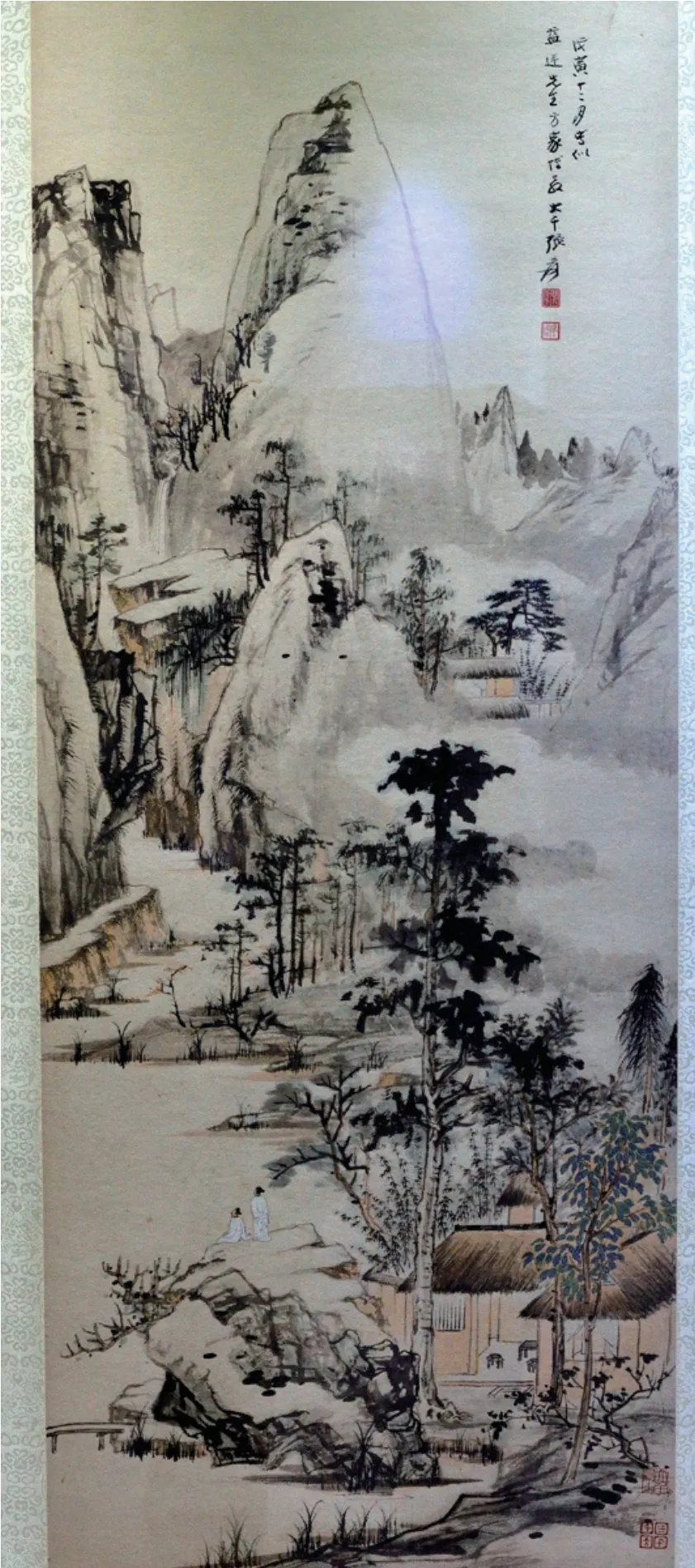
Light Crimson Tinge Landscape Painting (Zhang Daqian)
2.5 Approaching the appraisal from preface and postscript
The prefaces and postscripts on calligraphies and paintings generally fall into three categories, i.e. those left by the artist, the artist’s peer or the artist’s junior, respectively. For a piece of work, the preface and postscript can often reflect its process and background of creation, and its record of collections and transfers. Also, people usually approach a piece of work and its artist (creator) through its preface and postscript. Consequently, it is common for forgers to tamper with the preface and postscript on a piece of work. For example, they could add a forged postscript onto a real ancient painting, or add an artist’s real postscript onto a forged ancient painting. There were also painters adding their own prefaces and postscripts onto forged paintings. Among those painters was Wu Changshuo, a modern painter who had the habit of completing several pieces in the morning, and then took a nap at noontime before he added inscriptions onto those pieces in the afternoon. Learning about his habit, some people thus secretly replaced his completed paintings with forged pieces before he added inscriptions onto those forged pieces without discrimination. There were also painters in their later years who mistook the imitations of their works by others for the authentic pieces of their own and subsequently added prefaces, postscripts or inscriptions onto them. If a piece of calligraphy or painting bears the inscription left by a contemporary of the artist, the relationship between the two people should be clarified. For example, Wei Jiuding’s painting Luo Shen Tu (Goddess Luo) bears a poem inscribed by Ni Zan. As Wei Jiuding and Ni Zan were close friends, now that Ni’s inscription has proved to be real and authentic, the painting must be Wei’s authentic piece. Regarding a preface or postscript contributed by the artist’s junior, more importance should be attached to the contributor’s identity and intellectual attainment. A well-known connoisseur’s preface or postscript surely helps identify or challenge the authenticity of a piece of work.
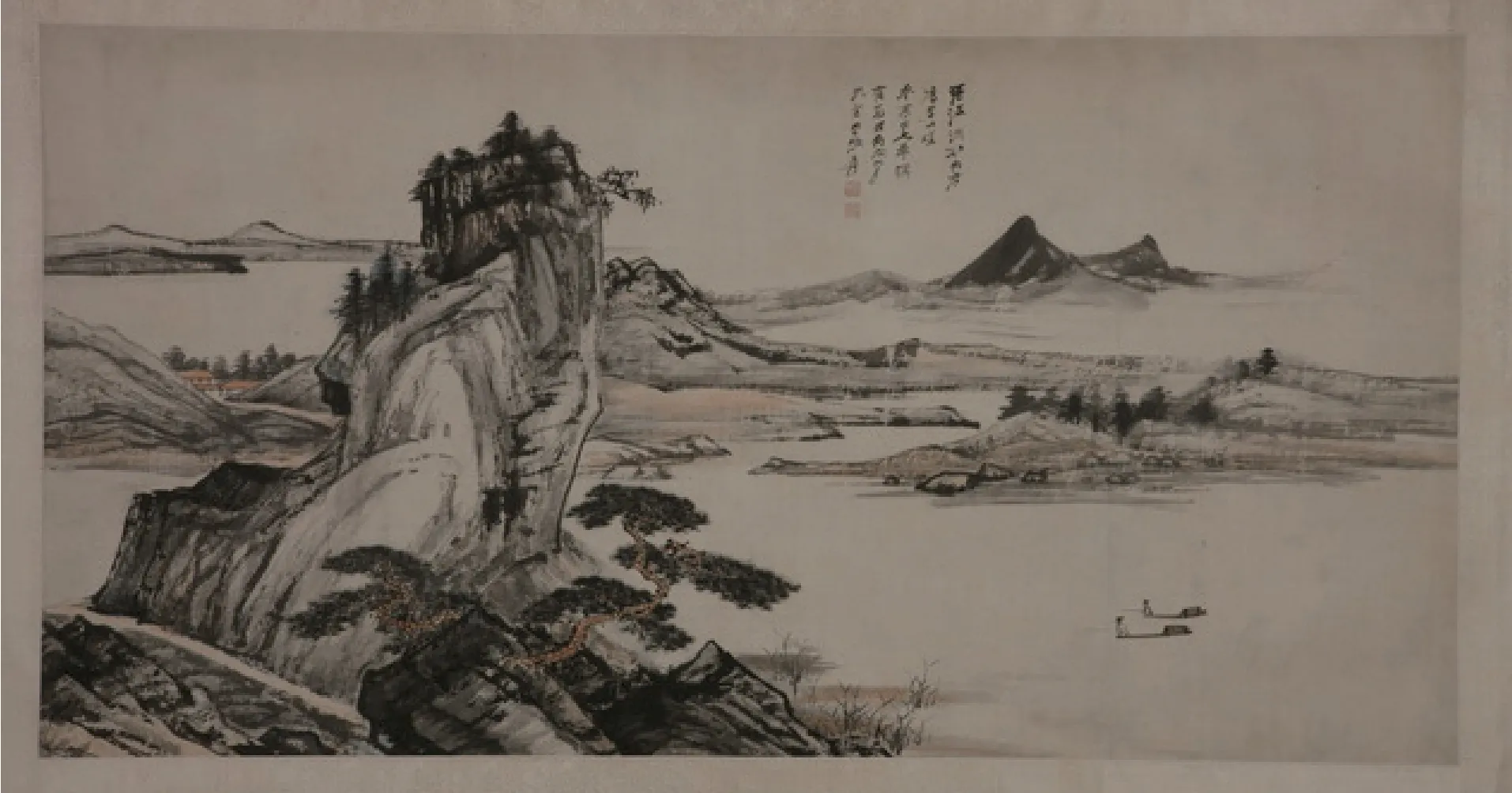
Two Men Fishing on Two Boats on a Tranquil River (Zhang Daqian)
2.6 Approaching the appraisal from collectors' seals
Collectors’ seals on calligraphies and paintings can help identify the authenticity of those works. Some masterpieces have changed hands many times among connoisseurs, each of whom had their own seals on them. By placing all relevant collectors’ seals in chronological order, viewers can catch a glimpse of a work’s origin and history, which is often known as “traceable lineage.” If a piece of calligraphy or painting bears any seal(s) of authoritative connoisseur(s), the piece is highly likely to be a true and authentic masterpiece. Of course collector’s seal could also be forged. In fact, the more famous the collector is, the more forged personal seals he or she could suffer. This needs to be guarded against with special caution.
2.7 Approaching the appraisal from related records and catalogs
In the past, it was a common practice for viewers and collectors to make a detailed record of the calligraphies and paintings they appreciated and collected, covering aspects such as content, preface and postscript, seal, size and mounting. Some of those records were gathered to compile a monograph. Those recorders, or authors, having worked hard on the appraisal of calligraphies and paintings, had certain judgment in this regard. Although occasional misjudgments are inevitable, they could be right in most cases. That explains why those records and catalogs are of significant reference value for today’s appraisal of ancient Chinese calligraphies and paintings.
2.8 Approaching the appraisal from mounting
The mounting of a calligraphy or painting can be deemed circumstantial evidence for its appraisal, although the mounting of such a piece has no direct influence on its artistic value. In Chinese history, each era had its own distinct thin silk, brocade, pattern, color, as well as mounting style. There were also differences in mountings between the imperial court and folk society. Even in folk society, mounting techniques and methods varied from north to south. A careful examination of all these differences and similarities in mounting materials, styles and techniques can help find clues for the appraisal. Accordingly, some forgers also tried all means to manipulate mountings for forgery purposes. One common trick is “cicada casting off its skin,” meaning retaining the original mount of a calligraphy or painting, taking the authentic piece out and embedding a forged piece into the mount to pretend it to be a true and authentic item.
3. Conclusion
In short, if connoisseurs can make comprehensive research, conduct analysis and induction according to the eight basic approaches while appraising ancient Chinese calligraphies and paintings, they can find more clues to sift the true from the false and draw a valid conclusion.
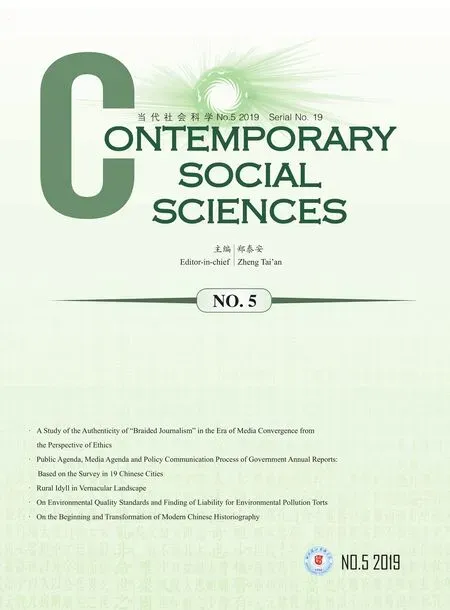 Contemporary Social Sciences2019年5期
Contemporary Social Sciences2019年5期
- Contemporary Social Sciences的其它文章
- American Sunday-School Libraries in the 19th century
- Emotion and Memory: Emotional Guidance for the History Education of the Nanjing Massacre
- On the Beginning and Transformation of Modern Chinese Historiography
- Rural Idyll in Vernacular Landscape
- On Environmental Quality Standards and Finding of Liability for Environmental Pollution Torts
- Public Agenda, Media Agenda and Policy Communication Process of Government Annual Reports:Based on the Survey in 19 Chinese Cities
